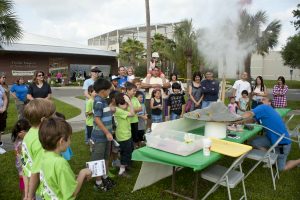Editors note: A complete list of activities follows this release

Florida Museum of Natural History photo by Kristen Grace
GAINESVILLE, Fla. — The Florida Museum of Natural History is celebrating its 10th year of volcanic eruptions and geological discoveries at “Can You Dig It?” March 12 from 10 a.m. to 3 p.m.
This free, fun-for-all-ages event provides visitors an opportunity to uncover Earth’s geological wonders through hands-on activities and educational demonstrations.
Those who haven’t attended in recent years can look forward to new additions and changes. University of Florida geology professor Thomas Bianchi, who worked on the Deepwater Horizon Oil Spill, will lead an activity allowing participants to discover how chemistry is used to clean up these environmental accidents.
“As we continue to drill in deeper waters, it is important for people to look at some of the problems with deep sea drilling and challenges with cleanup,” Bianchi said.
Other returning favorites include the augmented reality sandbox, make your own earthquake and deep ocean drilling, where participants can sample their own “drill core.”
Program organizer Matt Smith, a senior lecturer and undergraduate adviser in the UF department of geological sciences, said the volcanoes station has recently been completely revamped to include more participant interaction. Smith said he hopes to have the biggest turnout ever this year.
Participants can collect stamps on a “passport” as they visit each station, and redeem the completed card for a prize.
“We take geology for granted, but it affects our lives in so many different ways,” said Florida Museum public programs coordinator Catherine Carey. “The event is a fun and exciting way to learn about geology all around us – especially when the volcano goes off.”
“Can You Dig It?” is sponsored by the UF department of geological sciences and Florida Museum of Natural History in collaboration with the Gainesville Gem and Mineral Society, Creative Environmental Solutions and EAM2 Services.
Food from High Springs Orchard and Bakery will be available for purchase. For more information, visit www.floridamuseum.ufl.edu/canyoudigit or call 352-273-2064.
-30-
Writer: Sara Uman, PRintern@flmnh.ufl.edu
Source: Catherine Carey, ccarey@flmnh.ufl.edu
Media contact: Paul Ramey, pramey@flmnh.ufl.edu, 352-273-2054
Can You Dig It? Activities List
10 a.m.-3 p.m. • March 12
Florida Museum of Natural History
3215 Hull Road, Powell Hall on the UF campus
Activities occur throughout the day unless noted
Augmented Reality Sandbox‑Understanding topographic maps
This sandbox combines real sand with virtual reality to show how 2-D topographic maps show the 3-D shape of the land. Make your own surface in the sandbox and watch as the virtual reality projection mirrors your model. Then, make it rain in the sandbox and see how virtual water flows in your model.
Climate Proxy Records: Understanding Earth’s Changing Climate
Investigate how geologists reconstruct records of Earth’s past climates to better understand current climate change.
Fossil Discovery Cart
The Museum’s own Discovery Cart.
Gainesville Gem and Mineral Society
Meet local “rock hounds” and explore the transformation from rough stone to finished jewelry with members of the society. Watch demonstrations of cabbing and gem faceting, then get information about the club, events and how to join!
Gem and Fossil Mine
Sift for gems, minerals and other treasures.
Geologic Time Tunnel
Explore the “Tunnel of Time.” Take a journey back through time and explore our planet’s geologic history.
Groundwater‑Florida’s Precious Natural Resource
Investigate how groundwater flows through and shapes the subsurface while discovering Florida’s underground rivers. Then explore what you can do to protect our drinking water supply.
Investigating Ocean Acidification
The Earth is a big, interconnected system. Discover how increased carbon dioxide in the atmosphere can threaten the ocean’s coral reefs.
Make Your Own Earthquake!
Learn about how, why and where earthquakes happen, and then make your own earthquake to find out how you measure on the Richter scale.
Meteorites and Meteor-wrongs
Meteorites can and do strike the Earth. Check out these space rocks and see how they differ from other rocks found on Earth. Learn how to identify and distinguish real meteorites from look-a-likes.
Minerals, Minerals Everywhere
There are thousands of different kinds of minerals. Learn how geologists and mineral enthusiasts identify different types and try to identify some unknown specimens on your own.
Oil Spill and Cleanup
Investigate how chemistry is used to clean up these environmental catastrophes.
Paleobiology and Fossils
See fossils of amazing prehistoric life forms and explore Florida’s fossil heritage.
Paleomagnetism
Rocks contain their own compasses, and they don’t always point north! See how scientists use Earth’s magnetism to reconstruct how the continents have moved through time.
Passport Prizes
Grab a passport and collect stamps as you explore–then receive a prize for your completed passport.
The Power of Water: How the Land Gets its Shape
Use wave tanks and other interactive models to explore water’s power in shaping our ever-changing environment.
The Rock Cycle
Discover how rocks are continuously recycled on Earth into new rocks and learn about the different environments in which they form.
Secrets of Sand
Take an up-close look under a microscope to see the secrets of sand revealed.
Tools of a Geologist
Learn why geologists are the real “Inspector Gadgets” and bring your minerals and rocks to be identified.
UF Department of Geological Sciences
Learn about the UF geological sciences department, how to become a geologist and why geoscience is an excellent career choice.
Volcanoes (Periodic eruptions scheduled on the hour and half-hour starting at 10:30 a.m.)
Participate in ongoing interactive demos and investigate why some volcanoes erupt explosively while others often do not, but watch out – ours is ready to blow!
-###-